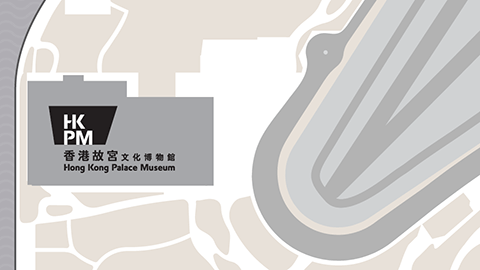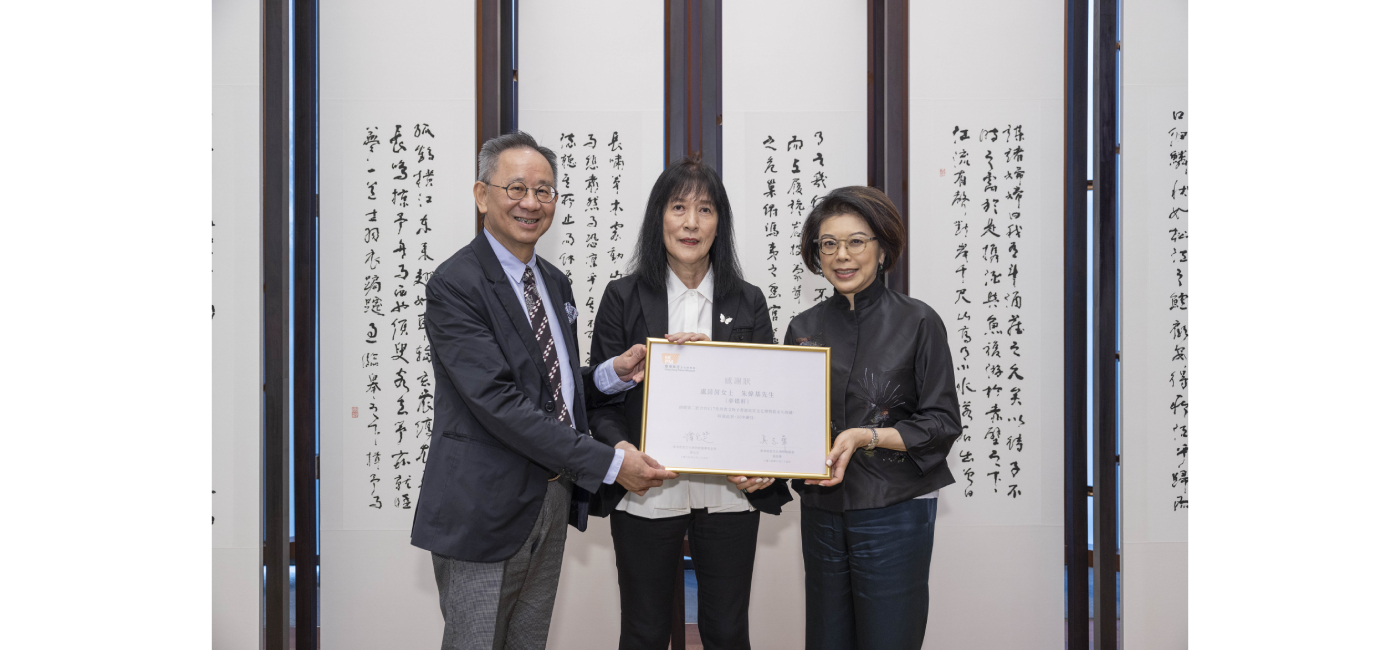With a total of nearly 1,400 ancient Chinese gold and silver objects, the Museum now has one of the world's most comprehensive and important museum collections of this kind
The Hong Kong Palace Museum (HKPM or the Museum) is pleased to announce a significant milestone on the occasion of the Museum’s second anniversary. Ms Betty Lo and Mr Kenneth Chu, owners of the Mengdiexuan Collection, generously gave the Museum their second major donation of 417 ancient Chinese gold and silver objects, bringing their total donation to nearly 1,400 pieces. Their earlier contribution of 946 gold and silver objects was made before the Museum’s opening in 2022. Together, the highly significant and generous donations from the Mengdiexuan Collection are the largest group of donations received by the Museum since its establishment.
At the donation ceremony held at the HKPM today, Ms Winnie Tam, Chairman of the HKPM Board, presented a certificate of appreciation to Ms Betty Lo and Mr Kenneth Chu in recognition of their generous donations. These spectacular donations have not only helped the Museum to build one of the world's most comprehensive and important museum collections of ancient Chinese gold and silver objects, but also laid a solid foundation for future academic research, exhibitions, publications and other projects.
All 417 treasures from the second donation of the Mengdiexuan Collection were featured in the special exhibition “Radiance: Ancient Gold from the Hong Kong Palace Museum Collection and the Mengdiexuan Collection” (“Radiance”) held in 2023. Well received by both experts and the public, the exhibition was named one of the “Top 100 Museum Exhibitions” in China and attracted over 330,000 visitors. Subsequently, the owners of the Mengdiexuan Collection decided to donate 417 exhibits of “Radiance” to the HKPM, demonstrating their trust and support for the Museum.
Ms Winnie Tam, Chairman of the HKPM Board, said, “The highly significant donation of 946 gold and silver ornaments in 2022 by Ms Betty Lo and Mr Kenneth Chu marked the first contribution of object gifts to the HKPM, solidifying the Museum’s leadership in collecting ancient Chinese gold and silver artefacts. Their second donation of over 400 treasures has not only enriched the Museum's collection but also laid a strong foundation for achieving its goal of establishing a world-class collection. The Museum extends heartfelt gratitude to Ms Betty Lo and Mr Kenneth Chu for their support in promoting Chinese cultural heritage and looks forward to inspiring more collectors to contribute to this important cause. The Museum pledges to all donors its commitment to best preserving, exhibiting, and utilising their donated precious works to enhance public understanding and appreciation of Chinese culture and art.”
Ms Betty Lo and Mr Kenneth Chu, Owners of the Mengdiexuan Collection, said, “We Mengdiexuan, as a Hong Kong collector, are committed to contributing to promote Chinese culture to the world. We believe this second donation to the HKPM will enhance and add tremendous value to the Museum’s present ancient Chinese gold collection, enriching its profile as well as expanding the scope of academic research and public education.”
Diverse and highly significant, artefacts from the second donation span three millennia, including a comprehensive and distinct assemblage of Liao-dynasty ornaments
Spanning over 3,000 years, this second donation of 417 pieces stands out for its exceptional quantity and quality as well as its distinctive features. It showcases the crowning achievements of Chinese goldsmithing. The artefacts come from the steppes, the plateaus, and the Central Plains. Their dates range from the Warring States period (475–221 BCE) to the Han dynasty (202 BCE–220 CE), the Six Dynasties (220–589), the Tang (618–907), Song (960–1279), Yuan (1271–1368), and Ming dynasties (1368–1644), as well as the Tubo Kingdom (7th–9th century), and the Liao dynasty (907–1125). The Liao ornaments are among the most distinctive and significant. Liao headdresses, necklaces, bracelets, rings, waist ornaments, and masks form one of the most comprehensive collections of gold and silver objects of this period housed in any museum in the world. Other notable pieces include a tiger-shaped ornamental plaque from the 3rd century BCE to 1st century CE; an ornamental hook with dragons from the Warring States period or the Western Han dynasty; a quiver ornament with imaginary animal and floral motifs from the Tubo Kingdom; a pair of hairpins with phoenixes from the Song dynasty; and a peony-shaped hairpin from the Ming dynasty. Despite the age of these delicately crafted gold objects, they retain their original lustre.
The Museum has curated multiple exhibitions to feature the donations from the esteemed Mengdiexuan Collection. The exhibitions include “Private to Public: The History of Chinese Art Collecting in Hong Kong”, which was held in 2022 as one of the Museum's opening exhibitions; the special exhibition “Radiance: Ancient Gold from the Hong Kong Palace Museum Collection and the Mengdiexuan Collection”, held in 2023; and the current exhibition “Passion for Collecting: Founding Donations to the Hong Kong Palace Museum”. “Radiance”, the largest exhibition of Chinese ancient gold ornaments in Hong Kong in recent years, spotlighted the 3,000-year illustrious history of Chinese gold artefacts and the remarkable artistic and technical achievements of ancient Chinese gold craftmanship. The exhibition also explored the crucial role of gold ornaments in political and cultural life and exchanges between various regions.
Actively plans domestic and international travelling exhibitions, champions the conservation work, and advances research on ancient Chinese gold artefacts and cultural exchanges between China and the world
Ms Betty Lo and Mr Kenneth Chu named their collection Mengdiexuan, “Butterfly Dream Studio” in Chinese, in reference to the ancient story of the Chinese philosopher Zhuangzi’s butterfly dream. The studio name, then, reflects the relationship between the collector and the objects being collected. The Mengdiexuan Collection is known, in particular, for the quality and the volume of ancient Chinese ornaments it contains. Its owners strongly believe that research requires a systematic and holistic approach. This is their underlying philosophy as they build their collection and make their donations. Spanning a few millennia, the gold objects in the Mengdiexuan Collection are important for studying goldsmithing in ancient China and cultural and material exchanges. Objects from their gold collection have been included in scholarly catalogues and shown at a number of museums, including the Chinese University of Hong Kong Art Museum and the Denver Art Museum in the United States.
Generous donations from the Mengdiexuan Collection have significantly enriched the Museum's collection and established a robust foundation for expanding our initiatives in the fields of research, exhibition, publication, conservation, learning, cultural enterprise, and international collaboration. Currently the Museum is working on a photography project documenting the Mengdiexuan donations and preparing a publication to promote the study of gold craftsmanship, as well as cultural and artistic exchanges between China and the world. Collaborations with international museums are underway with the goal of travelling an exhibition featuring the Mengdiexuan donations. Through a grant generously provided from the Bank of America Art Conservation Project, the Museum has had conservation-grade custom boxes made for the gold and silver pieces from the Mengdiexuan Collection. Additionally, five conservation experts from such highly regarded institutions as the Palace Museum and the National Museum of China have been invited to Hong Kong to work alongside the Museum's conservation team to conserve 12 objects. The Museum has also conducted, and will continue conducting, thematic workshops and lectures to engage the public.
Remarks
About the Hong Kong Palace Museum
The Hong Kong Palace Museum aspires to be a leading cultural institution committed to the study and appreciation of Chinese art and culture while advancing dialogue among world civilisations. The Hong Kong Palace Museum is a collaborative project between the West Kowloon Cultural District Authority and the Palace Museum. The Hong Kong Jockey Club Charities Trust made a donation of HK$3.5 billion for its establishment, as well as some of the annual exhibitions and education programmes in 2023–2031.
Embracing new curatorial approaches, the Museum offers a Hong Kong perspective and a global vision, presenting the finest objects from the Palace Museum and other important cultural institutions around the world. Through research, exhibitions, and educational and professional exchange programmes, the Museum will build international partnerships and help position Hong Kong as a global hub for art and culture. At heart a resource that belongs to the community of Hong Kong, the Museum will inspire community engagement, foster dialogue, and promote creativity and interdisciplinary collaboration.
About the West Kowloon Cultural District
The West Kowloon Cultural District is one of the largest and most ambitious cultural projects in the world. Its vision is to create a vibrant new cultural quarter for Hong Kong on 40 hectares of reclaimed land located alongside Victoria Harbour. With a varied mix of theatres, performance spaces, and museums, the West Kowloon Cultural District will produce and host world-class exhibitions, performances, and cultural events, providing 23 hectares of public open space, including a two-kilometre waterfront promenade.
https://www.westkowloon.hk/








